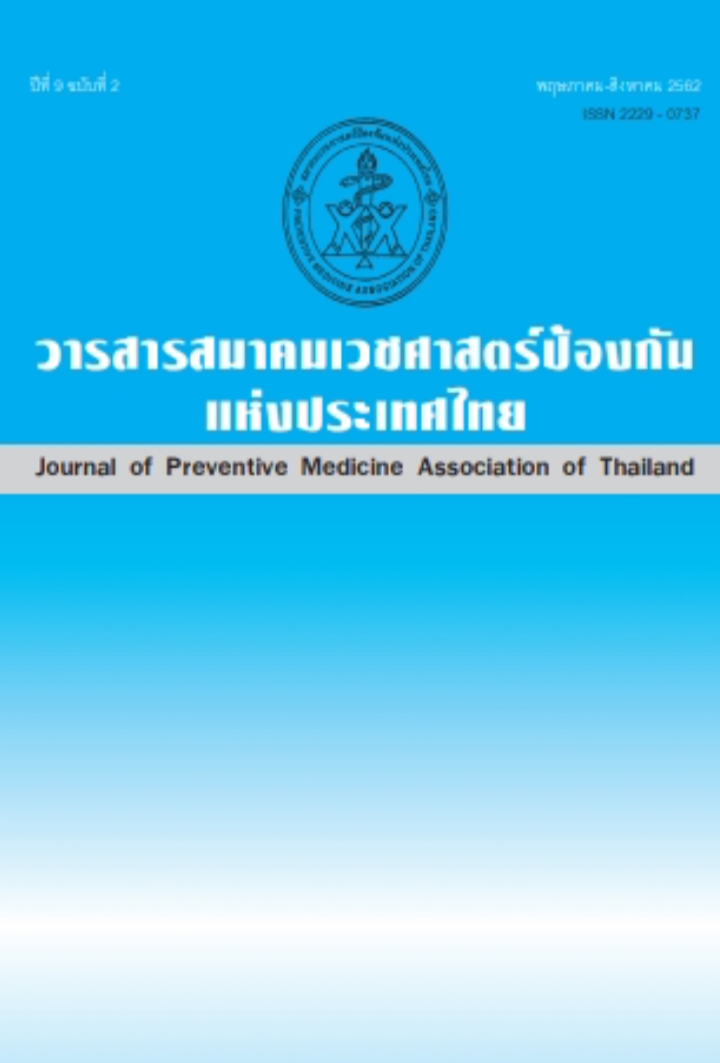Chrysanthemum Dermatitis in a Florist: A Case Report
Abstract
Florist was exposed to several occupational hazards, such as fungicide, insecticide, herbicide, and flowers especially many flowers that caused allergic contact dermatitis. Previous studies reported high incidence of occupational allergic contact dermatitis among the florist and the common cause was a chrysanthemum. Our study presents the clinical information on a patient diagnosed with occupational allergic contact dermatitis caused by chrysanthemum. A 31-year-old Thai male florist came to hospital with a complaint of a rash at dorsum of hands, forearms and neck for 2 months. He had no prior medical condition or skin diseases. The suspected contact allergens were chrysanthemum and gardenia flower because the occupational history revealed that he was usually exposed to them. The occupational physician ordered patch tested with Thin Layer Rapid Use Epicutaneous patch test (T.R.U.E. test), chrysanthemum leaf and gardenia leaf. Patch test revealed positive with parthenolide (sesquiterpene lactone), disperse blue 106 and chrysanthemum leaf. After, the patient avoided to contact chrysanthemum and received a medical treatment, the symptoms were better and he did not recurred. The occupational allergic contact dermatitis of this patient was caused by parthenolide, which found in chrysanthemum and plants of the compositae family (e.g., sunflower, cosmos, marigold and chamomile). Therefore, the patient with allergic contact dermatitis due to chrysanthemum should avoid exposure to the plants in the mentioned family.
References
2. Jungbauer FHW, Lensen GJ, Groothoff JW, Coenraads PJ. Exposure of the hands to wet work in nurses. Contact Dermatitis 2004;50:225-9.
3. Carder M, McNamee R, Gittins M, Hussey L, Agius R. Time trends in the incidence of work-related ill-health in the UK, 1996-2015: estimation from THOR surveillance data.[n.p.];2013.
4. แสงโฉม ศิริพานิช. การพัฒนาระบบเฝ้าระวังโรคจากการประกอบอาชีพและสิ่งแวดล้อมแบบเชิงรับ. กรุงเทพฯ:สำนักระบาดวิทยา; 2558.
5. Salminen WF, Roberts SM. Dermal and ocular toxicology: toxic effect of the skin and eyes. In: Williams PL, James RC, Roberts SM, editors. Principles of toxicology environmental and industrial applications. 2nd ed. Canada: John Wiley & Sons; 2000. p. 157-65.
6. Uter W, Lessmann H, Geier J, Schnuch A. Contact allergy to hairdressing allergens in female hairdressers and clients-current data from the IVDK, 2003-2006. J Dtsch Dermatol Ges 2007;5(11):993-1001.
7. Johansen JD, Frosch PJ, Lepoittevin JP. Contact Dermatitis. 5thEd. Heidelberg: Springer; 2011.
8. Paulsen E, Andersen KE. Clinical patterns of Compositae dermatitis in Danish monosensitized patients. Contact Dermatitis 2018;78:185-93.
9. Tan E, Leow YH, Ng SK, Goh CL. A study of the sensitization rate to sesquiterpene lactone mix in Singapore. Contact Dermatitis 1999;41:80-3.
10. Gordon LA. Compositae dermatitis. Australas J Dermatol 1999;40:123-30.
11. Lakshmi C, Srinivas C. Parthenium the terminator: An update. Indian Dermatol Online J 2012;3:89-100.
12. TRUE TEST. Disperse blue 106. [Internet]. 2014 [cited 2018 Dec 12]. Available from:https://bit.ly/2FGpLQL
13. Harshman J, Quan Y, Hsiang D. Phytophotodermatitis. Can Fam Physician 2017;63:938-40.
14. Schulz KH, Hausen BM, Wallhöfer L, Schmidt-Löffler P, Chrysanthemum allergy Pt II. Experimental studies on the causative agents. Arch Dermatol Forsch 1975;251:235-44.
15. Pareek A, Suthar M, Rathore GS, Bansal V. Feverfew (Tanacetum parthenium L.): A systematic review. Pharmacogn Rev 2011;5:103-10.
16. TRUE TEST. Parthenolide. [Internet]. 2014 [cited 2018 Dec 12]. Available from: https://bit.ly/2JFCmZI
17. Mitchell JC. Parthenium pollen-parthenium dermatitis. Contact Dermatitis 1981;7(4):212-7.
18. Jovanović M, Poljacki M. [Compositae dermatitis]. Med Pregl. 2003;56(1-2):43-9.
19. Lepoittevin J-P, Berl V, Giménez-Arnau E. Alpha-methylene-gamma-butyrolactones:versatile skin bioactive natural products. Chem Rec 2009;9:258-70.
20. Mathias CG. Contact dermatitis and workers’ compensation: criteria for establishing occupational causation and aggravation. J Am Acad Dermatol 1989;20:842-8.
Downloads
Published
How to Cite
Issue
Section
License
บทความที่ลงพิมพ์ในวารสารเวชศาสตร์ป้องกันแห่งประเทศไทย ถือเป็นผลงานวิชาการ งานวิจัย วิเคราะห์ วิจารณ์ เป็นความเห็นส่วนตัวของผู้นิพนธ์ กองบรรณาธิการไม่จำเป็นต้องเห็นด้วยเสมอไปและผู้นิพนธ์จะต้องรับผิดชอบต่อบทความของตนเอง






